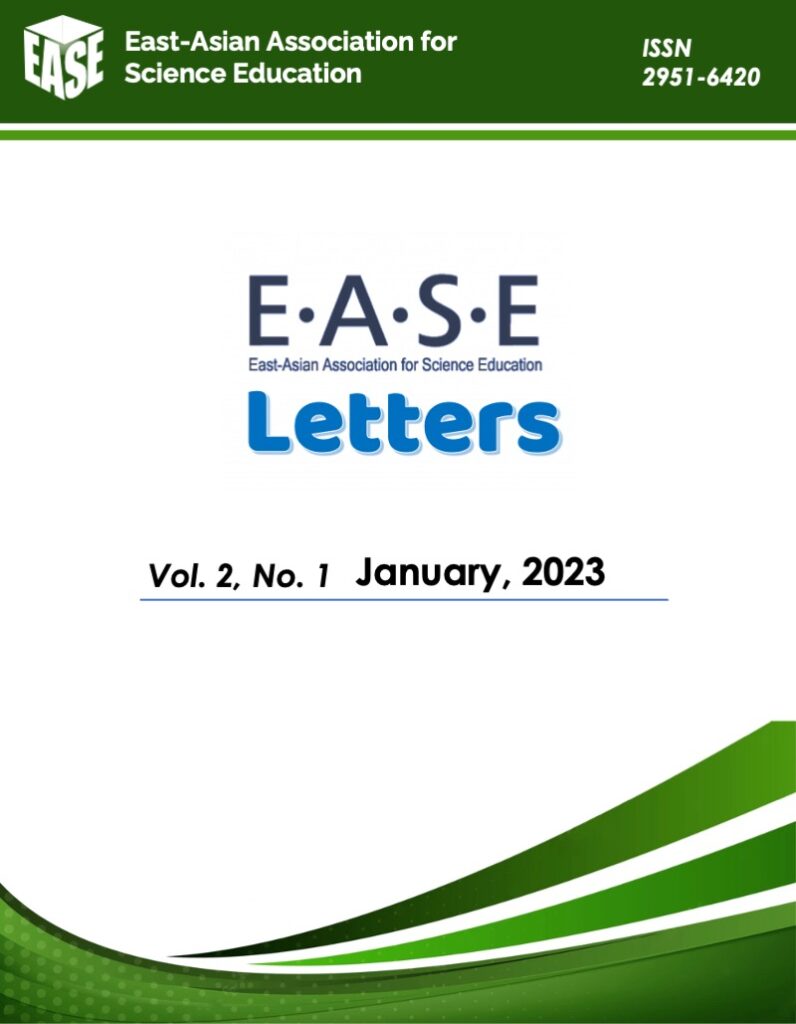EASE Letters, Volume 2. No. 1, 2023

Designing science lessons with socio-scientific issues and socio-scientific inquiry-based learning in Japan: A case study at upper secondary schools
Fujinami, Keigo; Isozaki, Tetsuo
Developing and conducting online SDGs workshops in collaboration with universities from Taiwan and the ASEAN countries
Nomura, Jun; Gutiérrez-Ortega, José Said; Maeda, Chisato; Morishige, Hina; Tsuji, Koji; Shimonagata, Shuji; Horn, Beverly
Safety of Physical Experiments Involving Resistance Heating
Morishige, Hina; Kato, Tetsuya
The Comparison of Physics at High School Level among the International Baccalaureate, Next Generation Science Standards, and the 2015 Science Curriculum of Korea
Authors: Shin, Myeong-Kyeong; Kwon, Gyeong-Pil; Kim, Eun-Jeong
Cite as: Shin, M. -K., Kwon, G. -P., & Kim, E. -J. (2022). The Comparison of Physics at High School Level among the International Baccalaureate, Next Generation Science Standards, and the 2015 Science Curriculum of Korea. EASE Letters, 2(1), 22-26.
Abstract: The aim of this study is to compare three curricula of Physics at high school level. The International Baccalaureate Diploma Programme (IB DP), Next Generation Science Standards (NGSS), and the 2015 Science Curriculum of Korea were analyzed for this study, and one of textbooks at university level was chosen as the standard for the comparison. Since each curriculums have the different structures, the factor to compare each curriculum was strongly associated with scientific knowledge. This is because it does not matter with the different educational system. In the 2015 science curriculum of Korea, ‘Core concepts’ and ‘Generalized knowledge’ as the structure of disciplinary knowledge were selected. The IB DP had a various learning goals depending on the unit school, so ‘syllabus content’ in physics guide by International Baccalaureate Organization, such a generalized scientific knowledge, was chosen for this research. Lastly, the analysis of NGSS was carried out the performance expectations which were integrated the three dimensions, including disciplinary core ideas, science and engineering practice, and cross cutting concepts. The results of this analysis are follows. First, there are two common parts out of six, such as ‘Mechanics’, and ‘Electricity and Magnetism’. Secondly, the proportion of ‘Modern Physics’ was low at every curriculum. Lastly, NGSS covers a smaller number of contents than the 2015 science curriculum of Korea and the IB DP
Keywords: 2015 Revised Curriculum; high school; IB DP; NGSS
How STEM is Integrated: A Methodological Approach
Saito, Tomoki
Gender roles during a high school chemistry laboratory experiment and their effect on the students’ science course selection
Sumida, Manabu; Yamane, Yumi
A DESIGN-BASED LEARNING ONLINE COURSE FOR PROMOTING SCIENCE STUDENT TEACHERS’ COMPETENCIES
Nugultham, Kulthida; Wannagatesiri, Tussatrin
WORIDEO (Worksheet with Interactive Video) TO OVERCOME TEACHER’S DIFFICULTIES WITH THE EXPERIMENT METHOD
Zahra, Ince Raudhiah; Riandi, Riandi; Suwarma, Irma Rahma; Chandra, Didi Teguh; Yuana, Ayu
How do one-year-old Young Children Explore the Shape of Things? An Analysis of the Characteristics of their Exploration Using the Scientific Toy of ‘Shape’
KOTANI, Takuya; TANIGUCHI, Mizuki; KOIDE, Mizuyo; YAMADA, Chieko
Characteristics of Modeling of Data as a Process of Creating Evidence and its Meaning on Science Education
Kim, Kwan-Young; Lee, Jong-Hyeok; Choi, Jinhyeon; Lee, Hyekeoung; Jeon, Sang-Hak; Lee, Sun-Kyung